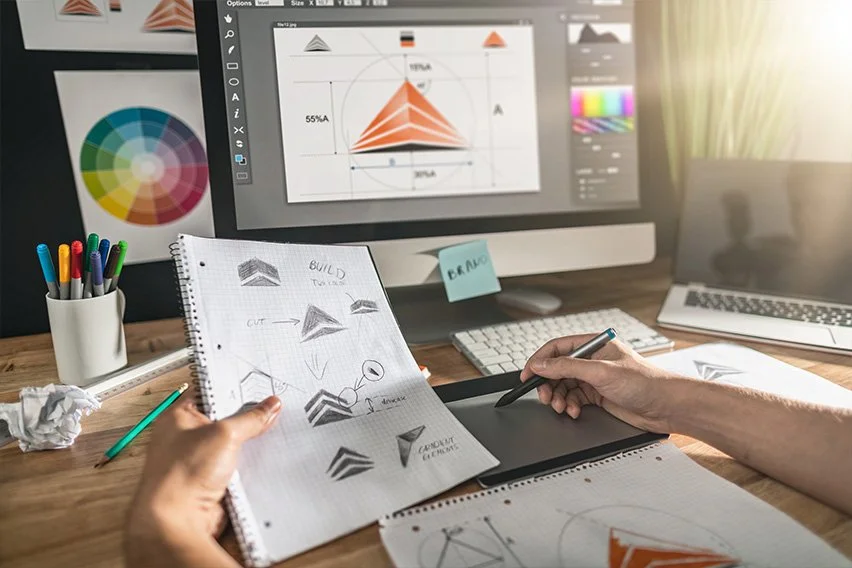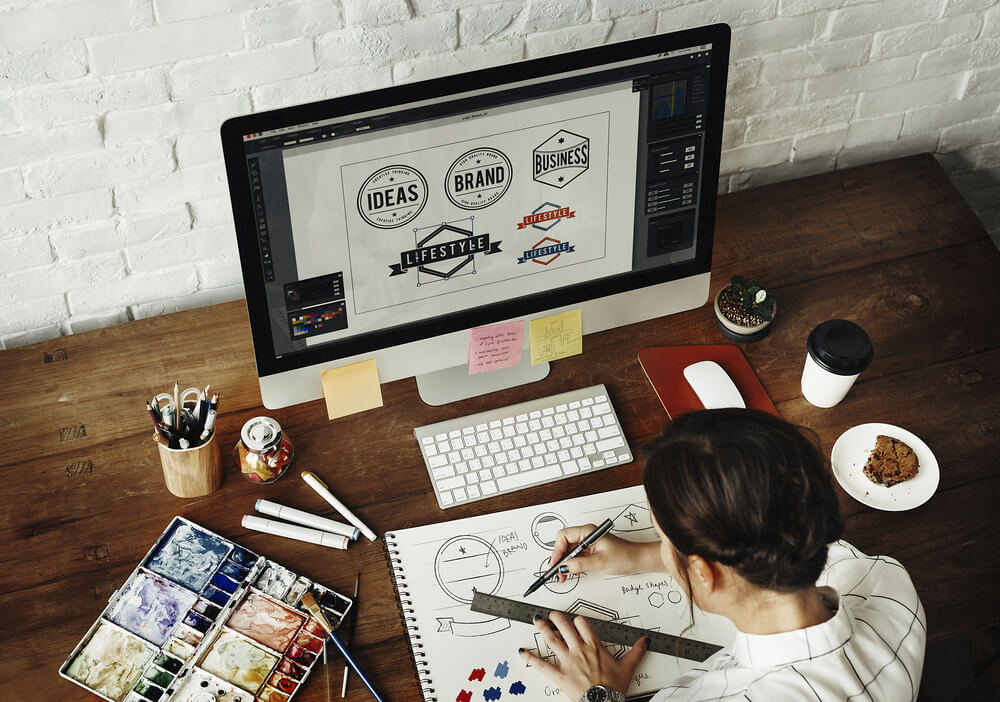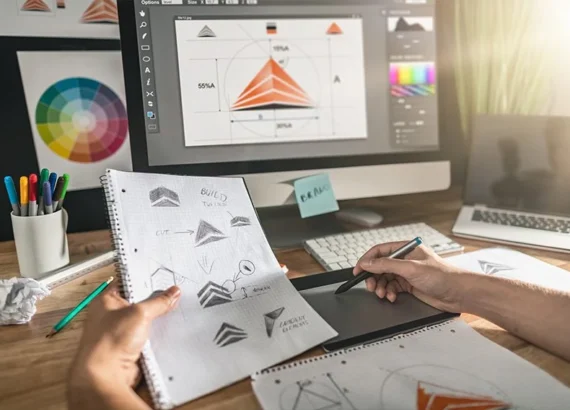How to Become a Graphic Designer Step-By-Step
Graphic design is a dynamic and creative field that combines artistry, technology, and communication to convey ideas, messages, and concepts visually. Whether it’s designing logos, websites, advertisements, or packaging, graphic designers play a crucial role in shaping the visual identity of brands and businesses. If you have a passion for creativity and visual aesthetics, becoming a graphic designer can be an exciting and fulfilling career choice. In this step-by-step guide, we will explore the essential skills, knowledge, and steps required to embark on a successful journey as a graphic designer. From building a strong foundation in design theory to mastering industry-standard software, creating a compelling portfolio, and finding opportunities in the industry, this guide will provide you with valuable insights and practical advice to help you navigate the path towards becoming a skilled and sought-after graphic designer.
1. Introduction to Graphic Design
What is Graphic Design?
Graphic design is like the magician behind the scenes, responsible for creating the visual magic that captures our attention and communicates messages effectively. It involves combining art and technology to convey ideas, information, or emotions through various mediums such as advertisements, websites, logos, and more. In simpler terms, it’s the art of making things look awesome!
Importance of Graphic Design in Various Industries
Graphic design is the secret ingredient that gives businesses the extra boost they need to stand out and thrive in today’s competitive world. From branding to marketing, graphic design plays a pivotal role in creating a strong visual identity for companies. It helps convey professionalism, build trust, and establish a distinct brand image. From fashion to food, healthcare to hospitality, graphic design has become indispensable in almost every industry.
Key Skills and Qualities of a Graphic Designer
To be a successful graphic designer, you need a blend of creativity, technical skills, and a dash of caffeine (just kidding!). Here are some key skills and qualities that can help you excel in this field:
1. Creativity: You should have a wild imagination and the ability to think outside the box.
2. Attention to detail: Graphic design is all about precision and getting those little details right.
3. Communication skills: You should be able to understand and interpret client briefs effectively.
4. Technical know-how: Familiarity with design software and tools is crucial.
5. Adaptability: The ability to adapt to different projects and work within specific guidelines is essential.
6. Time management: Deadlines are a designer’s constant companion, so being organized and efficient is a must.
2. Developing a Strong Foundation
Understanding the Basics of Design Theory
Think of design theory like the grammar of visual communication. It helps you understand the principles of layout, composition, balance, hierarchy, and more. By mastering design theory, you can create designs that are not only aesthetically pleasing but also effective in conveying the intended message.
Studying Color Theory and Typography
Colors and fonts have the power to evoke emotions, create moods, and influence perceptions. Learning about color theory and typography will equip you with the knowledge to choose the right colors and fonts for your designs. From understanding color combinations to selecting appropriate typefaces, these skills will help you create visually stunning and cohesive designs.
Exploring Different Design Styles and Trends
Design styles and trends evolve constantly, so it’s important to stay up-to-date. By exploring different design styles, you can develop a versatile and adaptable design sensibility. From minimalism to retro, from flat design to material design, understanding various styles will give you the freedom to experiment and create designs that resonate with your target audience.

3. Building Essential Design Skills
Mastering Sketching and Illustration Techniques
Sketching is the backbone of design. By honing your sketching skills, you can quickly and effectively communicate your ideas visually. Illustration techniques, on the other hand, allow you to create unique and eye-catching visuals. By combining sketching and illustration, you’ll have the power to bring your ideas to life.
Learning Image Editing and Manipulation
Image editing and manipulation skills are a graphic designer’s superpowers. From retouching photos to creating mind-bending compositions, these skills enable you to transform ordinary images into extraordinary works of art. By learning the tricks of the trade, you’ll be able to enhance your designs and create visually stunning masterpieces.
Practicing Layout and Composition
Layout and composition are the backbone of every design project. Understanding how to arrange elements, create visual hierarchy, and balance the overall composition are essential skills for any graphic designer. By practicing layout and composition, you’ll be able to create designs that are visually appealing, easy to navigate, and communicate messages effectively.
4. Exploring Graphic Design Software and Tools
Use Adobe Software like: Creative Suite (Illustrator, Photoshop, InDesign)
Welcome to the world of Adobe Creative Suite, where design dreams come true! Adobe Illustrator, Photoshop, and InDesign are the best software every for the graphic designer. Illustrator for creating vector-based graphics, Photoshop for image editing and manipulation, and InDesign for layout and publishing. Familiarizing yourself with these industry-standard tools will open up a world of possibilities for your designs.
Utilizing Vector-based Software for Powerful Designs
Vector-based software, like Illustrator, is a graphic designer’s best friend. Unlike raster graphics, which lose quality when resized, vector graphics can be scaled infinitely without any loss in quality. It is mostly use for creating logos, banners, posters, flyers, icons, and illustrations. By mastering vector-based software, you can create powerful and resizable designs that can be used across various mediums.
Enhancing Designs with Image Editing Software
Image editing software, like Photoshop, allows you to take your designs to the next level. From retouching images to creating photo montages, the possibilities are endless. By harnessing the power of image editing software, you can add that extra touch of magic to your designs and create visuals that leave a lasting impression.
So, are you ready to embark on your graphic design journey? Grab your creative cape and let’s get started! the Latest Design Trends and Techniques
5. Understanding Design Principles and Composition
Design principles and composition are the building blocks of a visually appealing and effective design. To become a skilled graphic designer, it’s essential to grasp these concepts and apply them in your work.
Applying the Rule of Thirds and Golden Ratio
Think of the rule of thirds and golden ratio as your secret weapons for achieving balance and visual harmony in your designs. By dividing your canvas into thirds or using the golden ratio, you can strategically place elements for maximum impact.
Balancing Elements with Symmetry and Asymmetry
Symmetry brings a sense of order and stability to a design, while asymmetry adds a touch of dynamism and intrigue. Understanding how to balance elements using both symmetrical and asymmetrical compositions will give your designs a polished and visually captivating look.
Creating Visual Hierarchy and Focal Points
Visual hierarchy refers to the arrangement of elements to guide the viewer’s attention and communicate the intended message effectively. By establishing a clear focal point and organizing elements based on their importance, you can create designs that are easy to navigate and visually engaging.

6. Creating a Professional Portfolio
A well-curated portfolio is your ticket to showcasing your skills and landing exciting graphic design opportunities. Here’s how you can create a portfolio that stands out from the crowd.
Showcasing Diverse Design Projects and Case Studies
Demonstrate your versatility as a graphic designer by including a range of design projects in your portfolio. From logos and brochures to websites and packaging, displaying a diverse body of work will showcase your adaptability and expertise.
Organizing and Presenting Your Portfolio Effectively
Organize your portfolio in a way that is easy to navigate and allows potential clients or employers to quickly grasp your capabilities. Consider categorizing your work, creating a consistent layout, and providing brief explanations of each project to provide context and insight into your design process.
Incorporating Your Unique Style and Branding
Differentiate yourself from other graphic designers by injecting your unique style and branding into your portfolio. Let your personality shine through and show how your design approach sets you apart from the crowd.
7. Finding Opportunities in the Graphic Design Industry
The graphic design industry offers a plethora of career paths and opportunities. Here’s how you can navigate your way to success:
Exploring Different Career Paths in Graphic Design
Graphic design is a vast field with various specializations. Take the time to explore different career paths, such as branding, web design, advertising, or motion graphics. Discovering your passion and interests will help you carve out a fulfilling career.
Building a Network and Establishing Professional Relationships
Networking plays very important role to grow in graphic design industry. Attend industry events, join design communities, and connect with fellow professionals to expand your network.
Leveraging Online Platforms and Job Boards for Opportunities
Tap into online platforms and job boards specifically catered to graphic design to discover exciting opportunities. Websites like Behance, Dribbble, and LinkedIn can serve as valuable resources for finding freelance gigs, internships, or full-time positions.

8. Continuing Education and Growth as a Graphic Designer
As a graphic designer, your learning journey is never complete. Keep growing and honing your skills with these tips:
Design trends and techniques evolve rapidly. Stay ahead of the curve by immersing yourself in design blogs, forums, and tutorials. Embrace new tools and technologies to expand your skill set and maintain relevance in the industry. Also Seeking Feedback and Critique to Improve Your Skills Feedback is crucial for growth..
Taking on Personal Projects to Expand Your Portfolio
Personal projects allow you to showcase your creativity and push the boundaries of your skills. Take on self-initiated design projects to experiment, explore new styles, and add fresh content to your portfolio.
Conclusion
With a solid understanding of design principles, a well-curated portfolio, a strong network, and a commitment to continuous growth, you’ll be well on your way to becoming a successful graphic designer. Keep honing your craft, maintaining a positive attitude, and embracing new opportunities, and who knows? You might just become the next design superstar! In conclusion, becoming a graphic designer is an enriching and rewarding journey that requires dedication, continuous learning, and a passion for creativity. By following this step-by-step guide, you have gained valuable insights into the foundational skills, industry tools, and career opportunities that await you in the world of graphic design. Remember, practice makes perfect, so continue honing your skills, exploring new design trends, and staying inspired to unleash your full creative potential. Embrace the challenges, showcase your unique style through a professional portfolio, and seize every opportunity to grow as a graphic designer. With perseverance and a strong work ethic, you are well on your way to building a successful career in this exciting field.
FAQ
1. Is a degree in graphic design necessary to become a graphic designer?
While a degree in graphic design can provide a strong foundation and enhance your skills, it is not always necessary to have a formal education in this field. Many successful graphic designers have built their careers through self-study, online courses, workshops, and practical experience. What matters most is developing a strong portfolio and demonstrating your skills and creativity to potential clients or employers.
2. What software do graphic designers typically use?
Graphic designers often use industry-standard software such as Adobe Creative Suite, which includes programs like Adobe Illustrator, Photoshop, and InDesign. These tools are widely used for creating vector graphics, editing and retouching images, and designing layouts. However, there are also alternative software options available that are suitable for different design needs and preferences.
3. How can I find job opportunities as a graphic designer?
There are several ways to find job opportunities as a graphic designer. Networking is crucial in this field, so attending design events, joining professional organizations, and connecting with fellow designers can help you discover job openings. Online platforms and job boards specifically catering to creative industries are also excellent resources for finding freelance gigs or full-time positions. Additionally, consider reaching out directly to companies or agencies that align with your interests and portfolio, as they may have unadvertised job openings.
Thank you for reading 🙂













